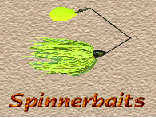
Spinnerbaits are probably the most versatile lure you will have in your box. It can be fished shallow, deep or anywhere in between.
Everyone has their favorites but some are better than others. Look for ball-bearing swivels on the blades and make sure the head flows with the wire. If there is any kind of lip there it will catch weeds and throw the lure out of balance. They may cost a little more but they are worth every penny.

|
When approaching a target, kill the bait. Letting the lure fall alongside your target will sometimes trigger a strike. When using a stinger hook, slip a piece of surgical tubing over stinger eye. When you thread it on it won't flop around, reducing hang-ups. When fishing any kind of drop-off, use a short arm single spin bait. They aren't as weedless but they do fall better. Instead of buzzing, try bulging the surface. Run the bait just under the surface creating a V-wake. If bulging doesn't work try breaking the surface intermittently. Speed up the retrieve so that the blade occasionally breaks the surface. Color is a matter of personal choice but white and chartreuse for clear to slightly stained water, and black for darker water is a good start. Carry an assortment of blades so that you can change if you need to. Colorado blades create more noise and vibration while Willow Leafs create more flash. When fishing docks or stumps make sure that your lure bumps into it. The deflection or change of direction will sometimes trigger a strike. Try to fish parallel to edges whenever possible. This will keep your bait in the strike zone longer than if you were to cast to an edge and pull it away. When fishing logs, weed edges, docks etc. cast to the shady side first whenever possible. When fishing reeds, cast in the direction the stems are bent. Your lure will track better moving with the grain rather than across it keeping your lure in the water longer. |
||
